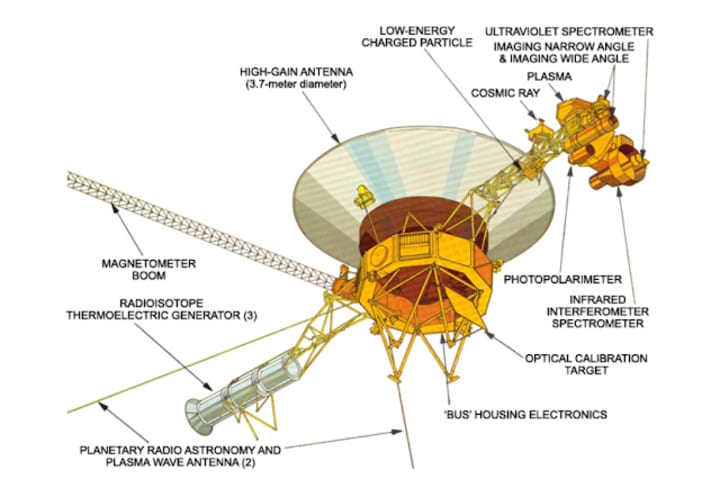How 'Star Wars' Influenced Real Life Space Missions
When Fiction Meets Reality

Space exploration became a household term in 1977. The Voyager 1 and 2 spacecrafts were launched to explore the solar system’s outer planets. That same year also saw another exciting launch: the Star Wars movies. Since 1977, Voyager spacecraft and Star Wars have been on remarkably parallel paths.
In May 1977, Star Wars broke just about every box office record as word of mouth quickly spread that this was the movie everyone should go see. The space opera storyline combined with impressive big-budget effects drew huge crowds on opening weekend and the following months. The film was initially called Star Wars, but after The Empire Strikes Back came out in 1980, it got the subtitle Episode IV- A New Hope, making it evident that at least three additional films were on the way.
RELATED: How The Lightsaber Was 'Forged'
Three months after Star Wars’ initial theatrical release, Voyager 2 spacecraft took off from Cape Canaveral. Like the Star Wars movies, the Voyagers were launched out of order. Following Voyager 2, Voyager 1 blasted off two weeks later, on September 5, 1977. Each Voyager spacecraft had a specific mission. Voyager 1’s mission was to explore Jupiter and Saturn while Voyager 2 took a longer route to study Neptune and Uranus. By the time the original trilogy was complete, Voyager 1 had completed its primary mission, but Voyager 2 was still making its way to Uranus and Neptune.

Remarkably, they are still regularly transmitting signals to the Deep Space Network. But nothing lasts forever. In May 2021, NASA reported on the continuous measurement of material density in interstellar space and the detection of interstellar sounds for the first time. After that, the transmitters will wear down, losing connection with the spacecraft. With the slight chance that intelligent life intercepts one of the Voyager’s, they will find a golden record on board, engraved with what is essentially a road map of our solar system. On the record are pictures and sounds that capture life on Earth in 1977.
By the end of the original trilogy, Star Wars would have such a positive impact on pop culture with its immensely successful Kenner action figure line. It would also pave the way for future toy lines while inspiring future scientists and astronauts. However, not everything about Star Wars was used in a positive light. Enter the U.S. government.
Space Fantasy Becomes Space Reality
As Star Wars became deeply entrenched in pop culture, it also inspired real-world science and technology. In 1983, President Ronald Reagan began the Strategic Defense Initiative, which would use a variety of weapons like ground and space-based lasers, particle beams, and missiles to help protect the United States from a nuclear missile attack. Critics referred to Reagan’s program as “Star Wars.” George Lucas hated the term and did not appreciate his movies being associated with weapons of war.
Appropriately enough, the defense system would have some components based in space. The idea was that a laser would shoot missiles down before they reached their target. The program also required surface-to-air missiles placed beside strategic locations such as intercontinental ballistic missile silos. The program was eventually abandoned due to budget cuts and possible anti-ballistic missile treaty violations. After $30 billion spent, no laser or mirror system was ever used.
That's No Moon! Yes It Is

Saturn’s moon Mimas eerily looks a lot like the Death Star with its distinctive circle on one side (maybe it is the Death Star, and it is just biding its time). Unfortunately, the circle is not a result of project Stardust but an impact crater from an asteroid. NASA astronomers use a Star Wars reference when discussing another one of Saturn’s moons, Iapetus, when they say it has a light side and a dark side.
Anytime astronomers discover a planet with two suns, they frequently reference Tatooine as it also orbits binary stars. The majority of the planets that orbit two suns are enormous gas giants, but a few planets similar to Earth have been found orbiting two suns, such as Kepler-16b, Kepler-34b, Kepler-35b.
Are They Droids Or Robots?

Even today, there is a real-life R2-D2, at least a twenty-first-century Earth version of one on the International Space Station (ISS). Although it more closely resembles C-3PO, NASA’s humanoid Robonaut 2 is sometimes called R2. Robonaut is still testing, but R2 is intended to flip switches and do other simple science experiments. In the future, NASA hopes to develop a version to work outside the space station rather than sending astronauts out on risky spacewalks. Unfortunately, Robonaut is not yet adequately protected to work outside the International Space Station. An earlier version of Robonaut bore a striking facial resemblance to Boba Fett’s helmet. This is the way.
Speaking of Threepio, as an interpreter, his role was to serve as a translator for his human companions, especially in formal settings. While robots do not have the ability to do that yet, in 2013, a Japanese child-like robot called Kirobo spoke with ISS commander Koichi Wakata about their trip into space. Kirobo’s job is to be an interactive robot for people who are lonely, astronauts in space, or isolated seniors who cannot readily leave their house.
In 2006, NASA launched droids to the space station to test synchronized flying in space (also known as the next Olympic sport). The goal is for the droids to be aware of each other and synchronize and coordinate their flight to avoid crashing into each other. This technology is similar to what the lightsaber trainer ball used in A New Hope.
Other Star Wars Tech In Space

What about different types of propulsion? Using our current technology, it would still take decades to reach even the nearest objects. Right now NASA is developing solar-electric propulsion that uses xenon ions. In Star Wars, the Imperial TIE fighters appear to use solar panels on their wings. Solar technology is something that NASA uses for many of its missions to Mars and the ISS. Typically, solar panels are most useful for spacecraft closer to the sun. Spacecraft operating farther away require nuclear power. Sorry, folks. No hyperspace yet.
While lasers are widely used in battle in Star Wars, NASA is testing out lasers for a much less deadly usage like high-speed communications between space and the ground.
Science fiction is the birth of science fact. In 1902, Georges Méliès created a short film called A Trip To The Moon. While making a film in 1902 was an achievement in itself, no one thought at the time that we would actually land on the moon until it happened 67 years later. While creating a real lightsaber may not be possible in 2022, who knows how Star Wars will inspire science and space exploration in the future.
Thank you for reading our article today. If you want to keep up to date with our latest stories, please consider becoming a pledge or, alternatively, please consider leaving a tip. This will help us continue to keep bringing new and interesting content. You can also check out our video content on the following YouTube channels, where you can subscribe to keep up to date: Star Wars Culture, Eye On Canon, The Star Wars Underworld, Chatter Squadron, The Roll Out, Meg in the Morning.
READ NEXT: Avid Fan Recreates Boba Fett & Cad Bane Showdown Using Action Figures
Written By Eric Onkenhout
Source(s): NASA, Forbes, Space
Syndicated From Culture Slate






Comments
There are no comments for this story
Be the first to respond and start the conversation.